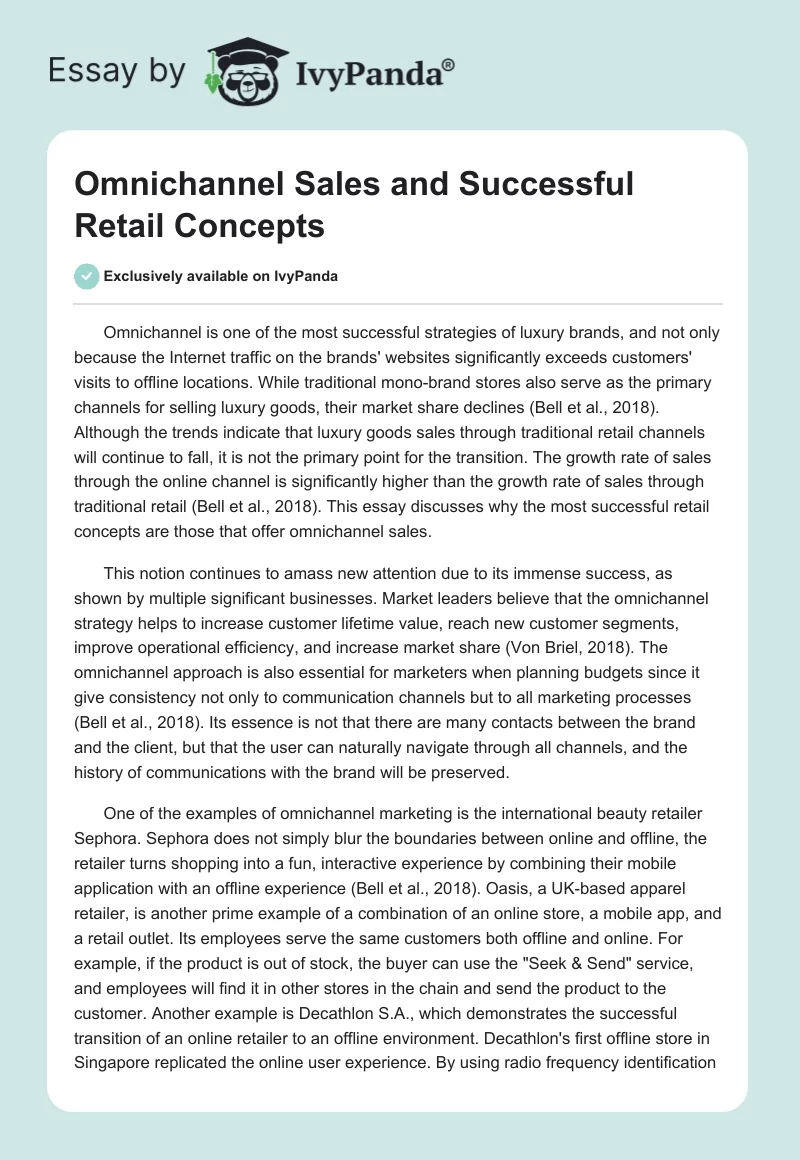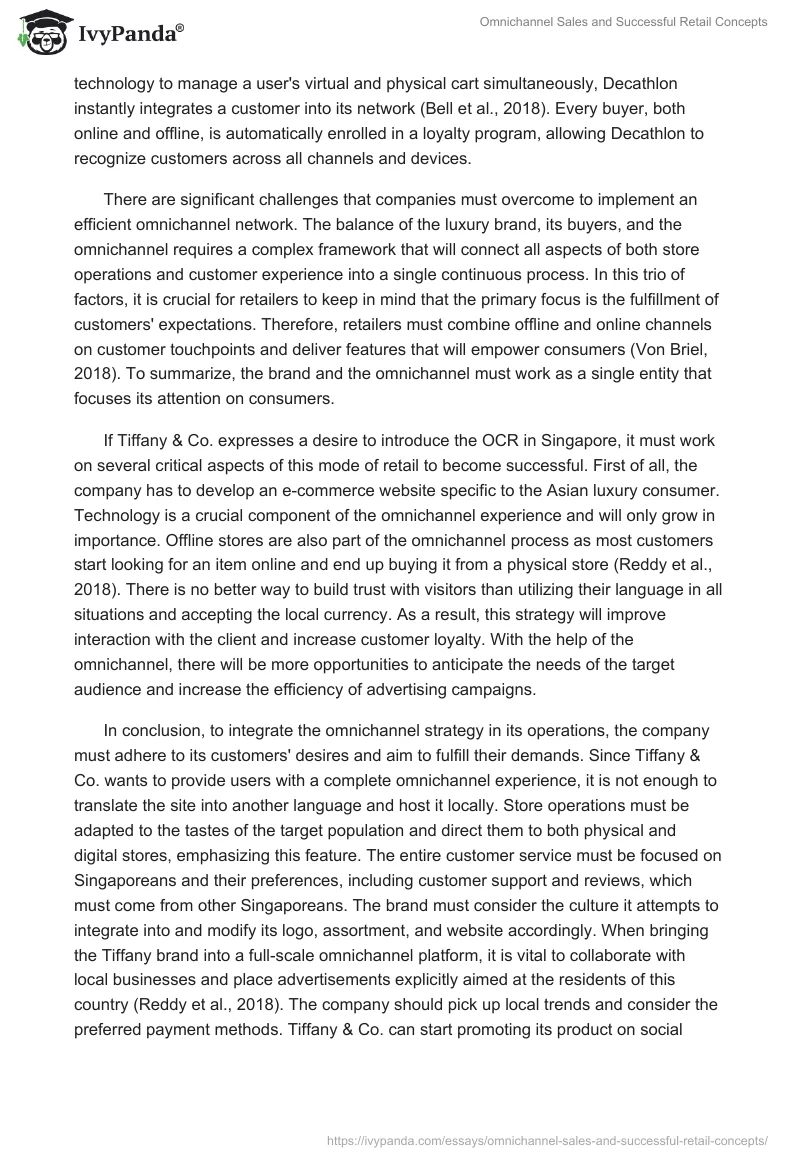Omnichannel is one of the most successful strategies of luxury brands, and not only because the Internet traffic on the brands’ websites significantly exceeds customers’ visits to offline locations. While traditional mono-brand stores also serve as the primary channels for selling luxury goods, their market share declines (Bell et al., 2018). Although the trends indicate that luxury goods sales through traditional retail channels will continue to fall, it is not the primary point for the transition. The growth rate of sales through the online channel is significantly higher than the growth rate of sales through traditional retail (Bell et al., 2018). This essay discusses why the most successful retail concepts are those that offer omnichannel sales.
This notion continues to amass new attention due to its immense success, as shown by multiple significant businesses. Market leaders believe that the omnichannel strategy helps to increase customer lifetime value, reach new customer segments, improve operational efficiency, and increase market share (Von Briel, 2018). The omnichannel approach is also essential for marketers when planning budgets since it give consistency not only to communication channels but to all marketing processes (Bell et al., 2018). Its essence is not that there are many contacts between the brand and the client, but that the user can naturally navigate through all channels, and the history of communications with the brand will be preserved.
One of the examples of omnichannel marketing is the international beauty retailer Sephora. Sephora does not simply blur the boundaries between online and offline, the retailer turns shopping into a fun, interactive experience by combining their mobile application with an offline experience (Bell et al., 2018). Oasis, a UK-based apparel retailer, is another prime example of a combination of an online store, a mobile app, and a retail outlet. Its employees serve the same customers both offline and online. For example, if the product is out of stock, the buyer can use the “Seek & Send” service, and employees will find it in other stores in the chain and send the product to the customer. Another example is Decathlon S.A., which demonstrates the successful transition of an online retailer to an offline environment. Decathlon’s first offline store in Singapore replicated the online user experience. By using radio frequency identification technology to manage a user’s virtual and physical cart simultaneously, Decathlon instantly integrates a customer into its network (Bell et al., 2018). Every buyer, both online and offline, is automatically enrolled in a loyalty program, allowing Decathlon to recognize customers across all channels and devices.
There are significant challenges that companies must overcome to implement an efficient omnichannel network. The balance of the luxury brand, its buyers, and the omnichannel requires a complex framework that will connect all aspects of both store operations and customer experience into a single continuous process. In this trio of factors, it is crucial for retailers to keep in mind that the primary focus is the fulfillment of customers’ expectations. Therefore, retailers must combine offline and online channels on customer touchpoints and deliver features that will empower consumers (Von Briel, 2018). To summarize, the brand and the omnichannel must work as a single entity that focuses its attention on consumers.
If Tiffany & Co. expresses a desire to introduce the OCR in Singapore, it must work on several critical aspects of this mode of retail to become successful. First of all, the company has to develop an e-commerce website specific to the Asian luxury consumer. Technology is a crucial component of the omnichannel experience and will only grow in importance. Offline stores are also part of the omnichannel process as most customers start looking for an item online and end up buying it from a physical store (Reddy et al., 2018). There is no better way to build trust with visitors than utilizing their language in all situations and accepting the local currency. As a result, this strategy will improve interaction with the client and increase customer loyalty. With the help of the omnichannel, there will be more opportunities to anticipate the needs of the target audience and increase the efficiency of advertising campaigns.
In conclusion, to integrate the omnichannel strategy in its operations, the company must adhere to its customers’ desires and aim to fulfill their demands. Since Tiffany & Co. wants to provide users with a complete omnichannel experience, it is not enough to translate the site into another language and host it locally. Store operations must be adapted to the tastes of the target population and direct them to both physical and digital stores, emphasizing this feature. The entire customer service must be focused on Singaporeans and their preferences, including customer support and reviews, which must come from other Singaporeans. The brand must consider the culture it attempts to integrate into and modify its logo, assortment, and website accordingly. When bringing the Tiffany brand into a full-scale omnichannel platform, it is vital to collaborate with local businesses and place advertisements explicitly aimed at the residents of this country (Reddy et al., 2018). The company should pick up local trends and consider the preferred payment methods. Tiffany & Co. can start promoting its product on social media by using local influencers, as well as opening physical stores to create a fully omnichannel experience.
References
Bell, D. R., Gallino, S., & Moreno, A. (2018). Offline showrooms in omnichannel retail: Demand and operational benefits. Management Science, 64(4), 1629-1651.
Von Briel, F. (2018). The future of omnichannel retail: A four-stage Delphi study. Technological Forecasting and Social Change, 132, 217–229. Web.
Reddy, S. K., da Silva, G., & Bhardwaj, S. (2018). Tiffany & Co: Omni-channel strategy for the Asian luxury consumer. Singapore Management University, 1-22.


